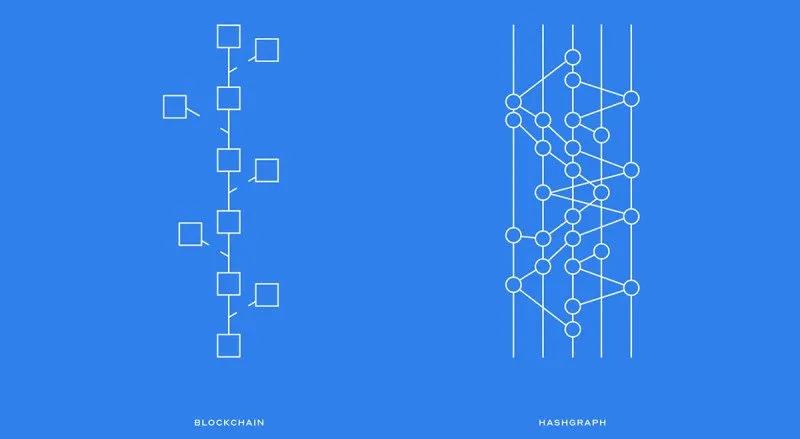
Bitcoin is famous as the cryptocurrency that introduced us to blockchain, a decentralized and transparent public ledger that used distributed computing to record transactions. But it was slow, and as Bitcoin became popular, that slowness in updating the ledger became obvious as it handled too few transactions per second.
Lots of entrepreneurs are working on speeding up the blockchain. But there’s something else out there called the hashgraph, another decentralized ledger that is billed as a fast and cheap alternative to blockchain. Today, the Hedera Hashgraph Council and MZ (formerly Machine Zone) are unveiling plans for a new distributed public ledger, the Hedera Hashgraph Platform.
This technology will be able to perform many transactions per second, and it could be the basis for a new level of trust and security in the online world, the supporters said. The Hedera group wants to use the ledger to enable anyone to make fast, secure, fair, and globally distributed applications. If you want to pause and watch this hashgraph video, be my guest.
The internet definitely has a trust problem. We’ve got loads of identity theft, cybercrime, spam, hacking, election manipulations, and digital spying — all things that have become the costs of living our lives online.
Hedera aims to change that with the release of a simple, powerful platform with robust applications programming interface (API) support to make it easy for developers to build global, distributed applications.
“We need a more trusted, secure and equitable online world,” said Leemon Baird, inventor of the hashgraph algorithm, in a statement. “You should be able to carve out a piece of cyberspace to create a shared world, be confident when interacting with others, feel safe online, control how you collaborate, and share only the information you want. Today we lay out the roadmap for how Hedera will make that happen.”
With the unveiling of the Hedera Hashgraph Platform, the council today also released speed test results, conducted on multiple Amazon Web Services platforms. The tests focused on achieving consensus on transaction order (resolving a ledger transaction) and timestamps for instances distributed across five continents.
The Hedera network was able to handle hundreds of thousands of transactions per second, with time to finality within a few seconds. Hedera uses verification software that runs on the computer’s graphics card GPU to verify one million signatures per second. Such speed is crucial to enable use cases such as distributed gaming, stock and other markets, and micropayments, the group said.
MZ said it will build distributed applications on top of hashgraph.
“Our mission is to enable the next generation of many-to-many applications,” said Gabe Leydon, CEO of MZ, in a statement. “By building on top of Hedera hashgraph, our applications will be able to be deployed in a peer-to-peer environment, with complete fairness, transparency and visibility. We believe Hedera is revolutionary, and will change everyone’s expectations of how fair and fast applications and gaming can be.”
Public distributed ledgers provide decentralized systems that, in theory, anyone can participate in. But a recent peer-reviewed study, titled “Decentralization in Bitcoin and Ethereum,” which examined some of the largest networks between 2015 and 2017, found the opposite has become true.
The top four Bitcoin mining operations and top three Ethereum ones control more than 50 percent of the world’s hash rate, and the entire blockchain of both systems “is determined by fewer than 20 mining entities” due to both the proof-of-work requirements and the lack of a governance model that ensures continued decentralization over time, Hedera said.
Hedera aims to address both of these concerns by separating governance from consensus. The Consensus Model ensures that the Hedera network will expand to many millions of nodes voting on the order of transactions in a highly distributed network. The cryptoeconomics of the platform help to ensure the continued decentralization of consensus voting.
Hedera expects to enable anyone to run a node without having to pay for a mining rig or large amounts of electricity. Hedera will be governed by a council of leading corporations and organizations across multiple industries, bringing needed experience in process and business expertise. Membership criteria is designed to reflect a range of industries and geographies with respected, trusted brands and market positions. The proposed governance model will ensure that no single entity has complete control and that no group of members has undue influence over the body as a whole. Hedera will use a combination of technical and legal controls to give the governing council mechanisms to promote stability and ensure the network will never fork.
The Hedera technical framework includes an Opt-In Escrow Identity mechanism that gives users a means to bind verified identities to otherwise anonymous cryptocurrency wallets, with the aim of providing governments the necessary oversight to ensure regulatory compliance. This is completely optional, and each user can decide what kinds of credentials, if any, to reveal. Hedera intends to work with governments to bring the same level of security to public ledgers as is currently present in the financial system.
Further details on Hedera will be unveiled at a sold-out event tonight in New York City. The event can be livestreamed at www.hashgraph.com, starting at 3 p.m. Pacific time.
Author Dean Takahashi